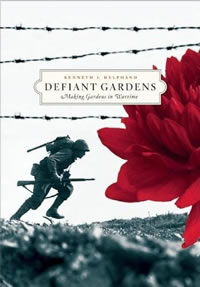 Defiant Gardens: Making Gardens in Wartime (2007) is not an easy book to read. The descriptions of the front lines, prison camps, Jewish ghettos, and Japanese internment camps from the first half of the 20th century are brutal, detailed, and very unsettling.
Defiant Gardens: Making Gardens in Wartime (2007) is not an easy book to read. The descriptions of the front lines, prison camps, Jewish ghettos, and Japanese internment camps from the first half of the 20th century are brutal, detailed, and very unsettling.
But this is also an important book to read. For those faced with the extremes of human suffering, “Gardens conformed to the expected cycle of seasons and growth and life; a garden was a demonstration of life in order, not a world turned upside down.”
Author Kenneth Helphand is a Pacific Northwest author–a professor of landscape architecture at the University of Oregon. He was motivated to write this book by an image of French soldiers beside their small vegetable gardens created while dug in at the front of World War I. His extensive research led him around the world to visit many of the original sites, even if the gardens are long gone.
While these observations give perspective, the heart of this book are the many personal narratives the author found in his research. These tell of the efforts despite great odds to nurture a garden, of the importance these gardens gave both for sustenance and emotional well-being, and the amazing strength of the human spirit.
Excerpted from the Spring 2012 Arboretum Bulletin.
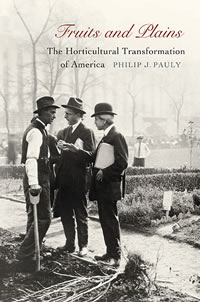 Philip Pauly was a professor of history at Rutgers University. His book, Fruits and Plains , was published by Harvard University Press. These are high academic credentials for a book that at first glance appears to be about gardening. But this is no ordinary gardening book. As suggested by the sub-title, The Horticultural Transformation of America, this is a serious study of the importance of horticulture to all aspects of American life particularly from the founding of the country well into the 20th century.
Philip Pauly was a professor of history at Rutgers University. His book, Fruits and Plains , was published by Harvard University Press. These are high academic credentials for a book that at first glance appears to be about gardening. But this is no ordinary gardening book. As suggested by the sub-title, The Horticultural Transformation of America, this is a serious study of the importance of horticulture to all aspects of American life particularly from the founding of the country well into the 20th century.
The key here is the term horticulture. To Pauly, “In general conversation it is an upmarket synonym for gardening” and includes the design, selection, and maintenance of plants in private and public gardens. But he uses the term more broadly and claims that in the 1800s, “horticulture was equivalent to what is now call plant biotechnology.”
The early history he recounts is focused on utility of gardens, particularly fruit producing trees and shrubs. Later he turns to arboriculture, highlighting the arguments for and against native and exotics species; century old arguments that continue today.
But of perhaps greatest interest is chapter nine, “Culturing Nature in the Twentieth Century”. Here are some keen insights to focus of gardeners today and the cultural environment at the time of the founding of the Washington Park Arboretum.
Excerpted from the Spring 2012 Arboretum Bulletin.
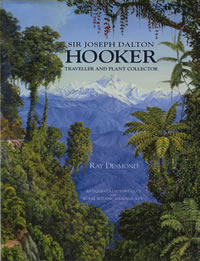 Sir Joseph Dalton Hooker: Traveler and Plant Collector (2001) by Ray Desmond is a marvelous travelogue, masking as a biography. Our hero took two multi-year expeditions (to Antarctica, New Zealand, and Australia from 1839-1843; and to India and the Himalayas from 1847-1851) as well as shorter trips to Morocco, Palestine, and the United States.
Sir Joseph Dalton Hooker: Traveler and Plant Collector (2001) by Ray Desmond is a marvelous travelogue, masking as a biography. Our hero took two multi-year expeditions (to Antarctica, New Zealand, and Australia from 1839-1843; and to India and the Himalayas from 1847-1851) as well as shorter trips to Morocco, Palestine, and the United States.
All the while he was observing, documenting, and collecting plants, leading to the publications of the native floras of these regions. Even better for us today, he was sketching the plants, landscapes, native peoples, and many other attractions. These sketches, and the botanical illustrations made by others from them, make this a richly illustrated book.
The text is engaging, detailing the trials of travel for both man and plants. Hooker “coped remarkably well with the rigours of botanising in the Himalayas. This he attributed to abstinence…a diet of meat and potatoes, and never over-eating.”
“His problems as a plant collector did not cease with the boxing and parceling of plants and seeds. Sometimes they were lost or dropped into rivers on the journey to Calcutta; often they died before they reached the port.” He tried wrapping seeds in “tins, oilcloth wrapping, paper packets. Sometimes he posted them in letters. But…too often they reached their destination damp or rotting or eaten by insects.”
Excerpted from the Spring 2012 Arboretum Bulletin.
 Cottonwood and the River of Time by Reinhard Stettler explores an unlikely topic, cottonwood trees and their kin including poplars and aspens. A retired University of Washington professor of forestry, the author writes an engaging natural history beginning with a single tree, an old matriarch near the Snoqualmie River. While eventually global in scope, many of the examples continue to be set in the Pacific Northwest.
Cottonwood and the River of Time by Reinhard Stettler explores an unlikely topic, cottonwood trees and their kin including poplars and aspens. A retired University of Washington professor of forestry, the author writes an engaging natural history beginning with a single tree, an old matriarch near the Snoqualmie River. While eventually global in scope, many of the examples continue to be set in the Pacific Northwest.
While many of the titles from the middle chapters may look a bit dull, e.g., “Natural Hybridization” and “Adaptation and Its Limits”, the writing is quite engaging and aimed at a general audience. The book concludes with cultural history of poplars–the importance of poplars in agriculture, forestry, and landscapes.
Excerpted from the Fall 2011 Arboretum Bulletin.
A stroll through the first 50 years of the Seattle Japanese Garden is a PowerPoint presentation with slides and narration, focused on the founding of the garden–with many historical photographs–and significant changes up to the present. This documentary on CD has a limited availability, but can be viewed with headsets at the Miller Library.
Excerpted from the Fall 2011 Arboretum Bulletin.
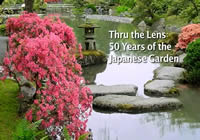 Thru the lens: 50 years of the Japanese Garden is a nearly hour-long documentary on DVD that explores both the history and current activities in the garden. Several docents, gardeners, and supporters are interviewed. I found the in-depth presentation of the tea ceremony particularly interesting. This documentary has a limited availability, but can be viewed with headsets at the Miller Library.
Thru the lens: 50 years of the Japanese Garden is a nearly hour-long documentary on DVD that explores both the history and current activities in the garden. Several docents, gardeners, and supporters are interviewed. I found the in-depth presentation of the tea ceremony particularly interesting. This documentary has a limited availability, but can be viewed with headsets at the Miller Library.
Excerpted from the Fall 2011 Arboretum Bulletin.
 The Gardener’s Color Palette at first glance is a pretty book, but I was prepared to dismiss it as having little information of consequence. However, like with most books, it is important to read the author’s introduction. Tom Fischer’s second sentence summarizes his intent: “Flowers are nature’s most direct and accessible route to enjoying the pure pleasures of color.”
The Gardener’s Color Palette at first glance is a pretty book, but I was prepared to dismiss it as having little information of consequence. However, like with most books, it is important to read the author’s introduction. Tom Fischer’s second sentence summarizes his intent: “Flowers are nature’s most direct and accessible route to enjoying the pure pleasures of color.”
As an experienced gardener, I was already familiar with almost all of the one hundred flowers (mostly herbaceous perennials) profiled. I know their size, habits, foliage, texture, and even fragrance, or lack of one. And color, of course. Or so I thought. Fischer, and the superb photographs of Clive Nichols, invites you to isolate color from all other qualities.
This is best done on the beginning page of each of the ten color groups, with thumbnail style, tight close-ups of the full view examples that follow. Here, the shape of the flower is gone; all that is left is the color. It’s quite a change in perspective.
The text gives a brief but insightful and often witty description of each plant, but the most valuable advice is for suggested companions, complimentary color ranges, or little gems like this entry on joe-pye weeds: “Their pinks and purples have a slightly dusty quality, which isn’t necessarily a drawback; in fact, a hot fuchsia joe-pye weed would be terrifying–what on earth would you do with it?”
Excerpted from the Fall 2011 Arboretum Bulletin.
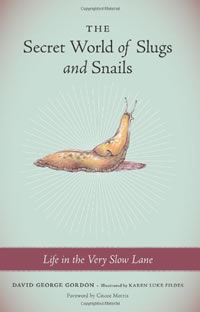 David George Gordon wrote a delightful booklet (48 pages) in 1994 titled Field Guide to the Slug. After chuckling over the concept, I found there was a lot of information packed in those few pages.
David George Gordon wrote a delightful booklet (48 pages) in 1994 titled Field Guide to the Slug. After chuckling over the concept, I found there was a lot of information packed in those few pages.
The Secret World of Slugs and Snails greatly expands the earlier work by not only including snails, but also the natural and cultural histories–yes, including cooking suggestions and even shell collecting–of these incredible creatures. For the even more adventurous, there is a short essay on keeping slugs as pets. For example, banana slugs have a good temperament for this (the author has a pair named Chiquita and Dole) but they will overheat in the typical household.
The final chapter is where most gardeners might begin: “Sharing Our Gardens: Coexisting with Slugs and Snails” but unlike in most gardening books, slugs and snails are not portrayed as an indisputable enemy. Yes, there are suggestions on how to both discourage and eliminate them, but the gardener is urged to have a heart and not apply salt as “…salting causes undue pain for the slug.”
Excerpted from the Fall 2011 Arboretum Bulletin.
 Among my favorites of recent new books is Lakewold: A Magnificent Northwest Garden. It reminds me of a well-crafted exhibit catalog, beginning with detail from an oil painting of the garden on the cover.
Among my favorites of recent new books is Lakewold: A Magnificent Northwest Garden. It reminds me of a well-crafted exhibit catalog, beginning with detail from an oil painting of the garden on the cover.
Inside a rich history of photographs–dating from the early 20th century and drawing from most decades since then–tell the story of a dynamic garden. As a gardener, I appreciated seeing the old and the new, the changes and what stayed, and the large scale, formal plantings that gave way to simpler plans.
The style and quality of the book is not surprising as the editor is Ronald Fields, Emeritus Professor of Art History at the University of Puget Sound, who has been a docent for Lakewold since it opened to the public in 1989. The choice and layout of photographs is quite engaging, and includes unexpected hardscape details, many close-ups of signature plants, and the people who shaped the garden–primarily Eulalie Wagner and Thomas Church.
Several short essays provide their own history, including those written by local horticultural luminaries Valerie Easton, Dan Hinkley, and Steve Lorton, recounting visits to Lakewold early in their careers. Other sections highlight the vitality of the garden that continues today and its importance amongst the great estate gardens in the country.
If nothing else, this book will make you want to visit Lakewold. We are very fortunate to have this garden close-by, open to the public, and continuing the vision and spirit of those who developed and shaped it.
Excerpted from the Fall 2011 Arboretum Bulletin.
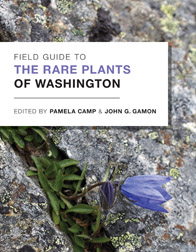 Most field botany guides help with identifying the most common trees, shrubs, and wildflowers. Field Guide to the Rare Plants of Washington takes a very different approach by choosing as its subjects over 300 of the rarest plants, ferns, and lichens in the state.
Most field botany guides help with identifying the most common trees, shrubs, and wildflowers. Field Guide to the Rare Plants of Washington takes a very different approach by choosing as its subjects over 300 of the rarest plants, ferns, and lichens in the state.
Why do this? Editors Pamela Camp and John G. Gamon, and the many contributors, anticipate that by helping both professional and amateur botanists in recognizing and identifying rare plants, this will promote conservation of these plants. The hope is also to engage more “…nature enthusiasts, opening a window into the beauty and diversity of Washington’s rare flora.”
That said, this book takes a solid base of botanical knowledge to appreciate. Selections are arranged alphabetically by genus within four broad plant types (lichens, ferns, dicots, and monocots). This means you must identify an unknown plant to the genus level before you can make use of the detailed plant and habitat descriptions to determine if you’ve found something rare. Most entries have line drawings and both close-up and site photographs, but these are for fine-tuning identification and not for the beginner.
Besides its value to the keen botanists, this book makes an important contribution to keeping pace with changes in taxonomy and nomenclature, and in linking different resources for this information. For example, each entry includes the name (if different) used in the standard reference Flora of the Pacific Northwest (Hitchcock and Cronquist, 1973). It also preserves in a book format much information that was only available in “…earlier loose-leaf and online treatments of many the species included…”
Excerpted from the Fall 2011 Arboretum Bulletin.
 Defiant Gardens: Making Gardens in Wartime (2007) is not an easy book to read. The descriptions of the front lines, prison camps, Jewish ghettos, and Japanese internment camps from the first half of the 20th century are brutal, detailed, and very unsettling.
Defiant Gardens: Making Gardens in Wartime (2007) is not an easy book to read. The descriptions of the front lines, prison camps, Jewish ghettos, and Japanese internment camps from the first half of the 20th century are brutal, detailed, and very unsettling. Philip Pauly was a professor of history at Rutgers University. His book, Fruits and Plains , was published by Harvard University Press. These are high academic credentials for a book that at first glance appears to be about gardening. But this is no ordinary gardening book. As suggested by the sub-title, The Horticultural Transformation of America, this is a serious study of the importance of horticulture to all aspects of American life particularly from the founding of the country well into the 20th century.
Philip Pauly was a professor of history at Rutgers University. His book, Fruits and Plains , was published by Harvard University Press. These are high academic credentials for a book that at first glance appears to be about gardening. But this is no ordinary gardening book. As suggested by the sub-title, The Horticultural Transformation of America, this is a serious study of the importance of horticulture to all aspects of American life particularly from the founding of the country well into the 20th century. Sir Joseph Dalton Hooker: Traveler and Plant Collector (2001) by Ray Desmond is a marvelous travelogue, masking as a biography. Our hero took two multi-year expeditions (to Antarctica, New Zealand, and Australia from 1839-1843; and to India and the Himalayas from 1847-1851) as well as shorter trips to Morocco, Palestine, and the United States.
Sir Joseph Dalton Hooker: Traveler and Plant Collector (2001) by Ray Desmond is a marvelous travelogue, masking as a biography. Our hero took two multi-year expeditions (to Antarctica, New Zealand, and Australia from 1839-1843; and to India and the Himalayas from 1847-1851) as well as shorter trips to Morocco, Palestine, and the United States. Cottonwood and the River of Time by Reinhard Stettler explores an unlikely topic, cottonwood trees and their kin including poplars and aspens. A retired University of Washington professor of forestry, the author writes an engaging natural history beginning with a single tree, an old matriarch near the Snoqualmie River. While eventually global in scope, many of the examples continue to be set in the Pacific Northwest.
Cottonwood and the River of Time by Reinhard Stettler explores an unlikely topic, cottonwood trees and their kin including poplars and aspens. A retired University of Washington professor of forestry, the author writes an engaging natural history beginning with a single tree, an old matriarch near the Snoqualmie River. While eventually global in scope, many of the examples continue to be set in the Pacific Northwest. Thru the lens: 50 years of the Japanese Garden is a nearly hour-long documentary on DVD that explores both the history and current activities in the garden. Several docents, gardeners, and supporters are interviewed. I found the in-depth presentation of the tea ceremony particularly interesting. This documentary has a limited availability, but can be viewed with headsets at the Miller Library.
Thru the lens: 50 years of the Japanese Garden is a nearly hour-long documentary on DVD that explores both the history and current activities in the garden. Several docents, gardeners, and supporters are interviewed. I found the in-depth presentation of the tea ceremony particularly interesting. This documentary has a limited availability, but can be viewed with headsets at the Miller Library. The Gardener’s Color Palette at first glance is a pretty book, but I was prepared to dismiss it as having little information of consequence. However, like with most books, it is important to read the author’s introduction. Tom Fischer’s second sentence summarizes his intent: “Flowers are nature’s most direct and accessible route to enjoying the pure pleasures of color.”
The Gardener’s Color Palette at first glance is a pretty book, but I was prepared to dismiss it as having little information of consequence. However, like with most books, it is important to read the author’s introduction. Tom Fischer’s second sentence summarizes his intent: “Flowers are nature’s most direct and accessible route to enjoying the pure pleasures of color.” David George Gordon wrote a delightful booklet (48 pages) in 1994 titled Field Guide to the Slug. After chuckling over the concept, I found there was a lot of information packed in those few pages.
David George Gordon wrote a delightful booklet (48 pages) in 1994 titled Field Guide to the Slug. After chuckling over the concept, I found there was a lot of information packed in those few pages. Among my favorites of recent new books is Lakewold: A Magnificent Northwest Garden. It reminds me of a well-crafted exhibit catalog, beginning with detail from an oil painting of the garden on the cover.
Among my favorites of recent new books is Lakewold: A Magnificent Northwest Garden. It reminds me of a well-crafted exhibit catalog, beginning with detail from an oil painting of the garden on the cover. Most field botany guides help with identifying the most common trees, shrubs, and wildflowers. Field Guide to the Rare Plants of Washington takes a very different approach by choosing as its subjects over 300 of the rarest plants, ferns, and lichens in the state.
Most field botany guides help with identifying the most common trees, shrubs, and wildflowers. Field Guide to the Rare Plants of Washington takes a very different approach by choosing as its subjects over 300 of the rarest plants, ferns, and lichens in the state.